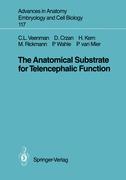- Start
- The Anatomical Substrate for Telencephalic Function
The Anatomical Substrate for Telencephalic Function
Angebote / Angebote:
The basic thesis for this study was that the telencephalon is needed to make decisions in new situations. Subsidary hypotheses were that the telencephalon consists of: (a) a sensorimotor system which generates motor activity from sensory input and (b) a selection system which makes choices from possible motor programs. It was postulated that the selection system should fulfil the following requirements: be accessible for past and present events, have the capacity to process this information in a nondetermined way with a possibility for ordering, and have access to motor-affecting systems (the sensorimotor system). The ability of the selection system to correlate information in a nonpredetermined way was considered most important. In short: The selection system should be able to associate any information in any combination, and have the capability for internal control of neuronal activity and external selection of motor programs (see Fig. IA. ) Xenopus laevis was chosen as a subject, since it has a relatively simple tel encephalon, with characteristics that it shares with "primitive" species of different vertebrate classes, and because it is easy to maintain as a laboratory animal. The main method used was the determination of connections with HRP. The pallium was in the focus of attention, since it was considered to be the core of the selection system. Immunohistochemistry was used as an additional parameter to compare Xenopus laevis forebrain with those of other vertebrates.
Folgt in ca. 5 Arbeitstagen
